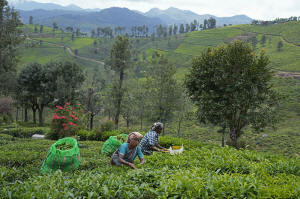In southern India's tea country, small but mighty efforts are brewing to
bring back native forests
 Send a link to a friend
Send a link to a friend
 [November 19, 2024] By
SIBI ARASU [November 19, 2024] By
SIBI ARASU
UDHAGAMANDALAM, India (AP) — Scattered groves of native trees, flowers
and the occasional prehistoric burial ground are squeezed between
hundreds of thousands of tea shrubs in southern India's Nilgiris region
— a gateway to a time before colonization and the commercial growing of
tea that reshaped the country's mountain landscapes.
These sacred groves once blanketed the Western Ghats mountains, but
nearly 200 years ago, British colonists installed rows upon rows of tea
plantations. The few groves that stand today are either protected by
Indigenous communities who preserve them for their faith and traditions,
or are being grown and tended back into existence by ecologists who
remove tea trees from disused farms and plant seeds native to this
biodiverse region. It takes decades, but their efforts are finally
starting to see results as forests flourish despite ecological damage
and wilder weather caused by climate change.
The teams bringing back the forests — home to more than 600 native
plants and 150 animal species found only here — know that they still
need to work around their neighbors. Nearly everyone in the region's
more than 700,000-strong population either farms black, green and white
tea or works with the almost 3 million tourists who come to escape the
searing heat of the Indian plains.
“In this time of climate change, I think ecological restoration and
rewilding is extremely important,” said Godwin Vasanth Bosco, a Nilgiris-based
naturalist and restoration practitioner. “What we’re trying to do is to
help nature restore itself.”

Degraded land and climate change threaten communities
Environmentalists say industrial-scale tea farming has destroyed the
soil’s nutrients and led to conflict with animals like elephants and
gaur, or Indian bison, that have little forest left to live in.
Estimates say nearly 135,000 acres of tea have been planted across the
mountains, damaging close to 70% of native grasslands and forests.
“There is no biological diversity," Gokul Halan, a Nilgiris-based water
expert, said of the tea farms. “It doesn’t support the local fauna nor
is it a food source.”
The forests among the tea farms are recognized by the United Nations as
one of the world’s eight “ hottest hotspots for biodiversity,” but the
areas degraded by excessive pesticide use and other commercial farming
methods have been dubbed “green deserts” by environmentalists for their
poor soil and inability to support other life.
The Nilgiris region has also had to clear land to facilitate the
increasing number of tourists and people from India’s plains who are
moving to the region.
Poorer land makes it more vulnerable to landslides and flooding, which
are now more common because of human-caused climate change. The
neighboring mountainous region of Wayanad suffered devastating
landslides that killed nearly 200 people earlier this year, and Halan
warns Nilgiris may suffer a similar fate.
Halan also warned the region is susceptible to long droughts and excess
heat because of climate change, and that's already affected some tea
harvests.
Restoring forests brings life back to Nilgiris
In a small mountain fold just a few hundred meters below the region’s
tallest peak, native trees planted 10 years ago have grown up to 4.5
meters (15 feet) tall. A stream flows amid the young trees that replaced
nearly 7 acres of tea plants.
“This whole place was tea plantations and this stream was not flowing
throughout the year,” said Bosco, the ecologist. “Since we began our
restoration work, it flows through the year and the trees and bamboo
have grown well along the stream.”
The forests are known as Shola-grassland forests or cloud forests
because they can capture moisture from high-altitude mist.
Bosco said the plants and trees have an “incredible capacity to provide
for life” across the nearly 2,000 acres his organization works to
restore. The native trees maintain the microclimate underneath them by
providing nutrients to the soil. That helps saplings and small plants
grow even during hot, dry summers.
[to top of second column] |

Workers pluck tea leaves using cutters at a tea estate in Nilgiris
district, India, Wednesday, Sept. 25, 2024. (AP Photo/Aijaz Rahi)
 The region is also home to several
Indigenous communities, called Adivasi, many of them classified as
highly vulnerable with only a few thousand of their people
remaining.
Representatives of these Adivasi communities consider themselves the
original custodians of the forests and have also restored forests in
the region. They say such restoration initiatives are welcome.
“When the British built tea estates, we were kicked out to the
fringes of this district, our lands were lost and we lost our
traditions because of deforestation,” said Mani Raman, who belongs
to the Alu Kurumbar Adivasi community.
“Such restoration work is good. By bringing the forests back, the
wildlife and birds will get more food. Animals that have moved out
of forests will have a place to live,” he said.
Tea growers still need a livelihood
Tea growers and factory owners say that the region's entire economy
depends on tea and it is relatively less harmful to the local
environment compared to rampant development to cater to tourism.
“To convert tea to grasslands and shola forests will have a negative
impact on the region’s economy and environment,” said A.
Balakrishnan, the owner of a two-year-old tea factory near the town
of Kotagiri in the Nilgiris.
Eighty-year-old I. Bhojan, who's been a tea grower all his life,
agrees. “There is no Nilgiris without tea,” he said.
Bhojan, president of the small farmers and tea growers welfare
association for the Nilgiris, estimates that around 600,000 people —
50,000 of them small farmers — depend on tea for their livelihood.
Balakrishnan argued that tea plants are maintained well given their
economic benefits compared to native forests.
“If tea was not there, Nilgiris will become a place for tourists
only, there'll be more construction and urbanization,” he said.
Finding common ground
Planting woody trees and shrubs in tea plantations, known as
agroforestry, can ease the battle for space between farms and
restoration, according to some experts.
Other crops and timber "can make tea plantations a bit more
biodiverse compared to what is there currently,” said water expert
Halan.
Officials of Tamil Nadu state, of which the Nilgiris district is a
part, earmarked $24 million earlier this year to encourage farmers
to shift away from chemical-laden fertilizers to help preserve soil
health. The state's forest department officials also announced plans
last year to plant nearly 60,000 native trees in the region.

Restoration ecologist Bosco said adding value to smaller tea farming
operations by growing special, higher-quality tea on smaller parcels
of land can open up more land to reforestation without hurting
farmers' pockets.
He added that if those working to restore the land were paid for
that service, that could be another stream of revenue for residents,
as well as sourcing new products to sell from the native plants.
“For example, we're trying to come up with products from some of the
plants that have medicinal value,” he said.
Raman added that future such work could also learn from Adivasi
traditional practices.
“Adivasi people have been protecting forests for so long, wherever
we live the forests are protected," he said. “The state government
should be taking such work up at large scale.”
All contents © copyright 2024 Associated Press. All rights reserved |